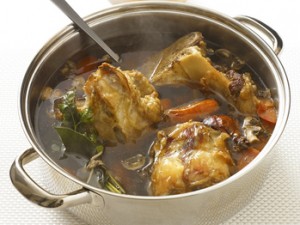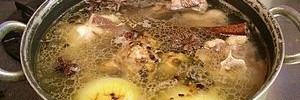Cooking a meat stock
Meat stock, based on cracked bones and sometimes raw meat, serves as the major ingredient for all meat soups and major meat sauces. Cooked meat will not yield the same flavor, although it is sometimes used. The more mature the meat, the better, because meat becomes more flavorful with age. In general, red meats contain more flavor than white (veal, pork). Some of the cuts most frequently used for meat stock include:
- Beef – Oxtail, chuck, shank, bottom round, and short ribs
- Pork – Hocks, ham bones, and boston butt
- Lamb – Shank, leg, shoulder
 The first step in preparing soup stock made with meat and/or bones is to cube or grind the meat, and/or cut the bones into 3-inch sections. This increases the surface area and improves extraction. To draw out even more flavor, some chefs first soak the meat or bones in a pot filled with cold water, using 2 cups of water to every cup of meat or pound of bones; or add enough water to cover the packed ingredients, plus 1.5 inches over. After half an hour to an hour of soaking, heat to the boiling point and then reduce it to a bare simmer for up to 3 to 4 hours. The bones and meat heated in the water will release gelatinous particles as the stock simmers that will cloud and form a scum on top of the liquid. Many chefs skim this scum layer before adding the vegetables.
The first step in preparing soup stock made with meat and/or bones is to cube or grind the meat, and/or cut the bones into 3-inch sections. This increases the surface area and improves extraction. To draw out even more flavor, some chefs first soak the meat or bones in a pot filled with cold water, using 2 cups of water to every cup of meat or pound of bones; or add enough water to cover the packed ingredients, plus 1.5 inches over. After half an hour to an hour of soaking, heat to the boiling point and then reduce it to a bare simmer for up to 3 to 4 hours. The bones and meat heated in the water will release gelatinous particles as the stock simmers that will cloud and form a scum on top of the liquid. Many chefs skim this scum layer before adding the vegetables.
Vegetables are often not added until the last hour or half hour of preparation, both to prevent their becoming mushy with overcooking and to preserve the desired flavor, which would become too concentrated and bitter with the water evaporation that takes place during longer cooking. Sometimes, however, vegetables are placed in the stock at the beginning intentionally so they will get mushy and can be pureed to act as a thickener. The size that vegetables are cut also makes a difference – large chunks are best for long-simmering stocks, while small pieces are added near the end of heating time.
